Architecture
This page aims to give details about some of the core architecture choices of SurrealDB, including details about the different layers which make up a SurrealDB instance, or SurrealDB cluster. SurrealDB is built using a layered approach, with compute separated from the storage. This allows us, if necessary, to scale up the compute layer, and the storage layer independently from each other.
Query layer
The SurrealDB query layer (otherwise known as the compute layer) handles queries from the client, analysing which records need to be selected, created, updated, or deleted. To begin with, the query engine runs the SurrealQL query through a parser, returning a parsed query definition. The parsed query is then run through the executor which breaks up each statement within the query, managing those transactions which should be run within the same transaction. Next, each statement is run through the iterator which determines which data should be fetched from the key-value storage engine, and handles index query planning, grouping, ordering, and limiting. Finally, each record is passed through the document processor, processing permissions, and determining which data is merged, altered, and stored on disk.
Storage layer
The storage layer handles the storage of the data for the query layer. Each storage layer implementation stores data in an ordered list, handling storage on disk, or sharding across a cluster. SurrealDB can use a number of underlying storage engines - some support concurrent readers, and some support concurrent readers and writers. Each storage engine must support a transaction-based approach, with the ability to support reading and writing of individual keys, and key ranges within each transaction.
RocksDB
In embedded mode, SurrealDB uses RocksDB to store data on disk. RocksDB is a high performance embedded database for key-value data. It is originally a fork of Google's LevelDB optimized to exploit many CPU cores, and make efficient use of fast storage, such as solid-state drives and high-speed disk drives. It is based on a log-structured merge-tree data structure.
TiKV
In distributed mode, SurrealDB can be configured to use TiKV to store data. TiKV is a highly scalable, low latency, and easy to use key-value datastore. TiKV supports raw and transaction-based querying with ACID compliance, and support for multiple concurrent readers and writers. The design of TiKV is inspired by distributed systems from Google, such as BigTable, Spanner, and Percolator, and some of the latest achievements in academia in recent years, such as the Raft consensus algorithm.
IndexedDB
When running in a web browser, SurrealDB can be configured to use IndexedDB to store and persist data within the web browser. SurrealDB first serializes both keys and values into a Uint8Array, utilizing IndexedDB as a binary key-value store - offering good performance, and with the ability to offer all of the functionality and features that SurrealDB offers when running in alternative ways.
Deployment architecture with TiKV or FoundationDB
When you have deployed an HA cluster (High Availability), you will have a deployment that resembles the following configuration


The HA deployment of your storage layer (TiKV, or FoundationDB) is the stateful part of the system. The rules governing the availability guarantees are covered in the documentation of those systems. SurrealDB clusters do not have state at the time of writing. Any necessary communication is either avoided by design, or communicated via the storage layer which maintains consistency. This makes deploying SurrealDB really convenient, since your fault tolerance is equal to the number of replicas (minus 1, the bare minimum number of instances). Even though we do have bootstrapping, by design nodes can come and go as they please without much interference.